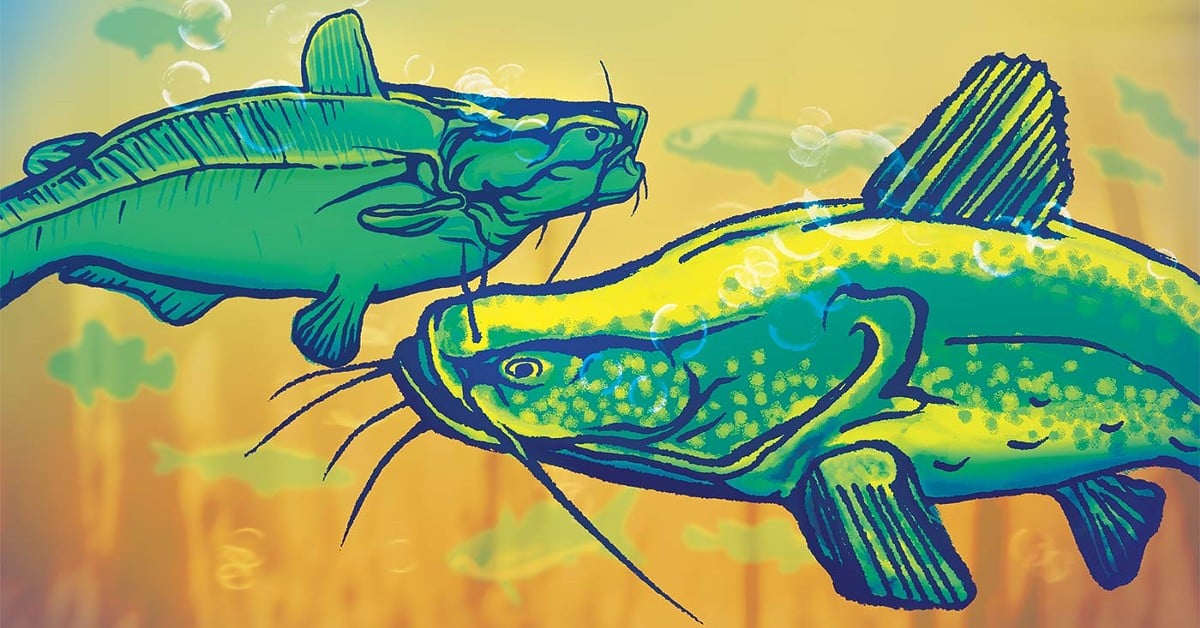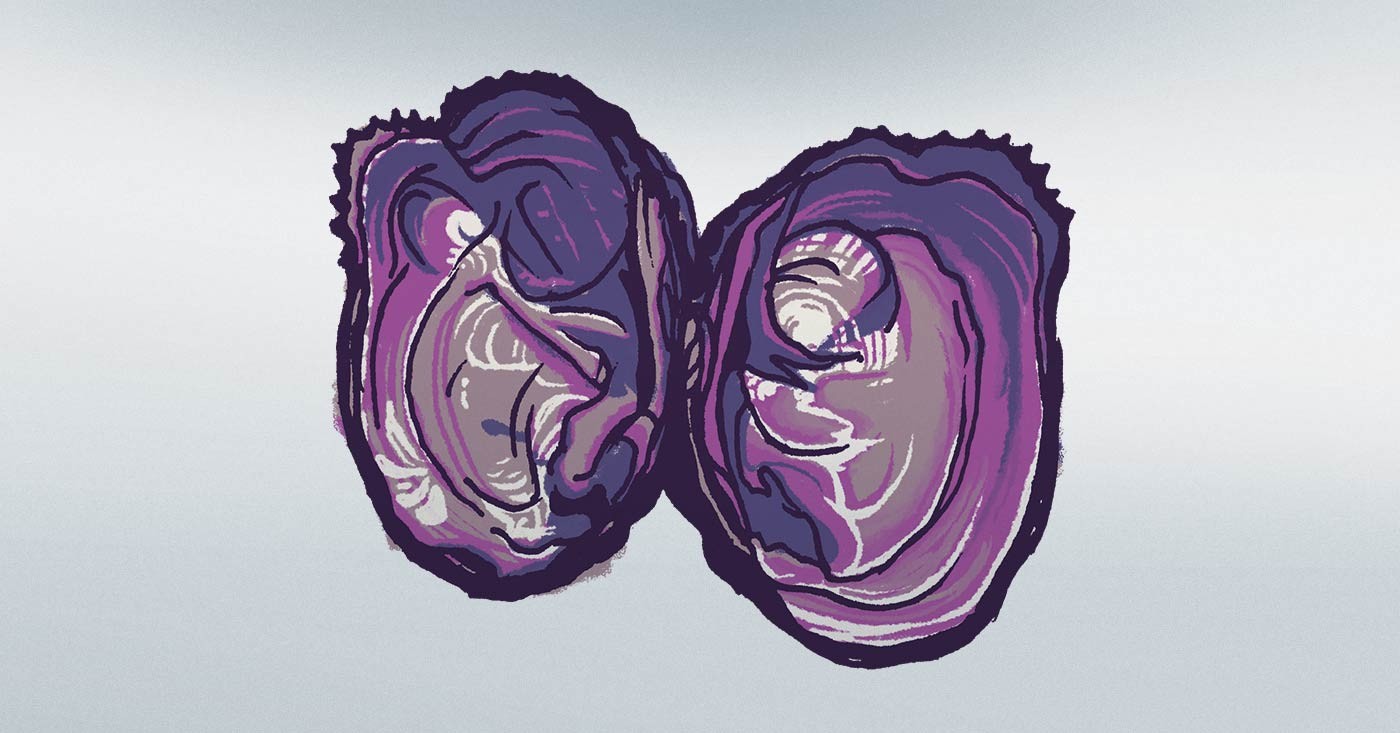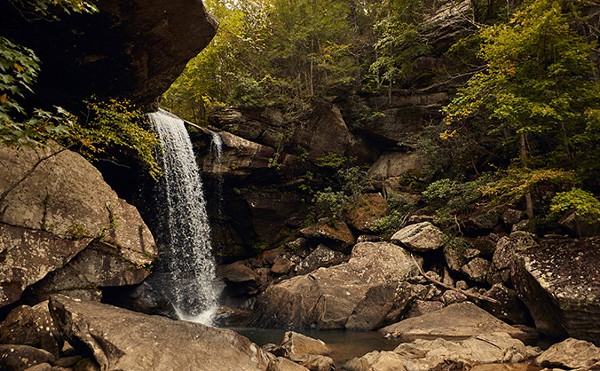Part I:
What lurks below
Troublesome Creek, which flows through the coalfields of Eastern Kentucky, drains close to 160,000 acres of mountainous terrain before emptying into the North Fork of the Kentucky River. The Hindman Settlement School sits beside the Right Fork, and it was here that Wendell Berry spoke in the summer of 2017 about the watershed uniting Eastern Kentucky and the Bluegrass Region.Berry’s writing cabin is across the road from his farmhouse, perched above the banks of the Kentucky River. “When I see the silt in the river,” he said, “I know that Eastern Kentucky is coming to me.” The river brings not only the mud of the region, he said, but also basketballs. The sport must be doing well in the mountains, he said.
Sitting in the audience, it occurs to me that both the silt and the detritus will come, in time, to where I live in the Ohio River Valley. More comes down the Ohio River, in fact, than I can ever tabulate, though I have seen all manner of fishing line, oil bottles and waterlogged aluminum cans.
Upstream from the fossil beds at the Falls of the Ohio, this jetsam of barges and weekend boaters splashes rhythmically along the shore. Lumps of coal lie along the sandy banks of Shippingport Island, downstream from the locks. Along the Louisville waterfront, turtles surface in water spoiled by red paint spilled from the fresh coating of a riverboat’s paddle wheel.
As obvious as these blemishes are, and knowing us to be downstream of historic steel mills and coke ovens, I assume the river’s damages run deeper.
Over the course of two decades, for example, DuPont discharged hundreds of thousands of pounds of perfluorooctanoic acid — PFOA, used in the production of Teflon — into the Ohio River at Parkinsburg, West Virginia. When DuPont’s internal documents were surrendered by court order, they revealed that the company had known about PFOA’s toxicity — it is linked to cancer and thyroid problems — for some 40 years.
Despite what seems like an intractable polluting of the river, it’s not uncommon to see mallards and geese swimming beneath the interstate bridges or night herons flying to roost in the evening. Fish as diverse as the paddlefish and American eel apparently thrive.
For those of us living in Louisville, we are downstream of far more than the coalfields of Appalachia and the cattle pastures of Berry’s Henry County. The Ohio River, 981 miles long, is the largest tributary of the Mississippi. Its watershed drains land in 15 states. Upstream lies Cincinnati, Wheeling, Pittsburgh and, ultimately, the Seneca reservation in New York, where the Allegheny River is named Ohi:yó.
This is what geneticist David Suzuki meant when he said, “We all live downstream.”
The Ohio River is the most polluted river in the United States. Its name, among the Iroquois, means “Good River.” It is the source of my drinking water and my daughter’s bath water. It is also the habitat for countless lives that live beyond the threshold of our perception.
Catfishing
I am aboard the Crown Jewel, drifting in the current beneath the Big Four Bridge. The Ohio River is, at this point, nearly 40 feet deep. I’m watching the sonar screen, which occasionally registers a long, curving blur. It’s a catfish, drifting along the riverbed near the pylon of the bridge.Eddie Brochin sets six poles in the rod holders, each hook baited with sliced sunfish. He lets out the line, paying attention to the side image projected on the Humminbird display screen above the wheel. Satisfied, he scrolls through his phone. “I need to play my favorite song,” he said. “Every time I play it, I catch a fish.” The song is Bon Jovi’s “Wanted Dead or Alive.”
This style of fishing is known as “bottom bumping,” or “longlining.” The cut bait or live bait, or both, is weighted and dropped into what Brochin calls the strike zone. The lines are dropped until the bait hits the bottom then cranked back up 2 or 3 feet. As we follow the contour of the river, it demands constant winding and dropping of the lines.
“I like drifting out in the open because it’s pleasurable,” said Brochin. “It’s not a lot of work and you don’t have to run the motor. You just drift with the wind.”
But this evening the winds are against us and we drift far faster than Brochin would like. He admits this wind makes fishing difficult. Usually, on the Ohio, one can expect a wind to blow east, north or south. But with the current already flowing west and the wind likewise blowing strongly in the same direction — a disruption caused by Hurricane Irma — the boat courses downstream rapidly. The engine idles, throttle in reverse, trying to maintain a position long enough for something to bite.
When something does, Brochin reacts immediately. “Grab the rod,” he yelled. I brace the cork handle against my hip and turn the reel. The pull on the line is strong, the drag intense. “Take your time,” Brochin said.
When the fish breaks the surface, I realize only later how focused I am in the moment. Entranced. Brochin reaches out a black net and we have it. It is a 7- or 8-pound channel cat, the first I’ve ever caught.
Brochin — or Captain Ed — shows me how to hold the fish, so he can get a picture. I cradle the 18-inch body, nearly pure muscle, before me. I feel the slime of its mucus-coated skin — catfish do not have scales — and watch the mouth pulse, gaping for breath. I gaze into its cloudy eyes and admire its whisker-like barbels. Brochin, for his part, would like to catch something larger if only for me to see how big a catfish can grow.
“Typically, a fish in this region, if it weighs thirty pounds, it’s about 25 years old,” Brochin explained. “If you got a 40-pound fish, you’re looking at a 35-year-old fish, and a 50-pound fish is about 45 years old. They grow an average of a pound to a pound-and-a-half a year.”
Fishing and the dominant predator
Over the course of nearly five hours, we twice maneuver out of the path of the coal and oil barges. “They’re the sharks,” Brochin said of the commercial traffic, “and I’m the minnow.” The wake from these vessels — not to mention the police boats roaring past us — left us bobbing. Brochin shakes his head at the disruption.The river at this point, above the locks of the canal, is surprisingly rich with catfish. Brochin claimed he reeled in an 80-pound flathead catfish one evening, and I believe him. The largest recorded flathead caught in this country was pulled from the Elk City Reservoir in Independence, Kansas, in 1998. It weighed 123 pounds. Catfish have been known to grow to 6 feet.
Catfish are in the order Siluriformes and date back 100 million years. They are defined as catfish not by the whiskers, but their heavy skull and a swimbladder that makes the catfish negatively buoyant — meaning they sink easily. The catfish is mostly a bottom feeder. Brochin repeatedly emphasized that catfish are the dominant predator in the river.
Many are nocturnal, which is why we are fishing into the oncoming dark. They live in the rivers or coastal waters of every continent but Antarctica. Some live underground, some in caves. Three catfish species inhabit the Ohio River: the blue cat, the channel cat and the flathead cat.
Brochin has been running fishing charters on the Ohio for catfish for nearly 25 years. He’s been fishing since he was 4, a skill taught to him by his father and grandfather. He’s the only one left in his family fishing commercially.
His concern, which has grown over the years, is that the big fish are declining in number. In the past, busy operating his business as a river guide and leading fishing expeditions, he didn’t think too deeply into the problem, he admits. But once he got on social media, he began seeing posts from other fisherman about the increasing problem with big-time commercial fishing. Brochin, to his credit, began a campaign to bring awareness to the decimation of the catfish, as he sees it — as many see it.
Wild west of fishing
Beginning in 2004, the Kentucky Department of Fish and Wildlife Resources initiated a study into the frequency, weight and age of catfish populations. One main reason for the study was increasing tension between recreational anglers and commercial fishermen who harvest trophy-sized catfish to sell to what are known as “pay lakes.”A pay lake, for the most part, is a man-made pond stocked with wild fish. Historically, Brochin said, the pay lakes stocked farm-raised catfish. When pay lakes began awarding cash prizes to patrons for catching the largest fish, things changed. Farms cannot grow a large catfish — only the river can support such a being. So the pay lakes began buying river-grown fish from commercial fishermen.
The state began the study of the Ohio’s three catfish populations because of — as its website says — a “perceived decline” in trophy catfish numbers. The state held a public meeting in October 2013 to present data to an audience of commercial and recreational fishermen. By November, it proposed regulations that allowed recreational fishermen, per day, one blue catfish greater than 35 inches, one flathead catfish greater than 35 inches and one channel catfish greater than 28 inches. Fish below those lengths would not be regulated.
For commercial fishermen, a different language was used, particularly for those who would be regulated by a lottery. Brochin, for his part, insists that such regulation is impossible. “Kentucky’s the Wild West when it comes to conservation for catfish,” he said. “Forget it, it’s every man for himself.” It doesn’t make it any easier when the river is also a state border — whether Indiana or Kentucky regulates the stretch of river running between downtown Louisville and Jeffersonville, where we are drifting, is unclear.
“Anyone can impose regulations, but who can afford to enforce them?” Brochin asked. “But I got to be honest, the state’s the one backing the commercial fishermen.”
Asian carp incursion
Once humans remove a top predator from any ecosystem, let alone the catfish from the Ohio, a chain reaction starts. What’s equally troubling is the introduction of the Asian flying carp into the U.S. river system. They were brought into the U.S. in the 1970s to help remove algae from retention ponds, but they escaped into the Mississippi and are migrating northward, the Courier Journal reported. The Asian carp are sometimes so thick that you can’t fish for anything else, Brochin said. A 30-pound fish hit his friend in the face at night and broke his nose.“Here in the river,” he explained, “the catfish have a plethora of natural baitfish, schools of baitfish like the shad and the mooneye and the skipjack herring and the sunfish and the suckers and the creek chubs. I mean, everything in the world lives in these rivers. And they also prey on other fish in their own species — the drum, the alligator gar, flying Asian carp — they keep the Asian carp in check. They eat the Asian carp. But once you remove all the big, top predators, then the Asian carp get out of whack.
“Instead of protecting the top predator,” Brochin lamented, “they’re yanking them out.”
Hours passed on the boat, and night fell. I pulled on a fleece. We drank a few beers. In Waterfront Park, a festival ended, and the tents were dismantled. Traffic flowed over the Second Street Bridge. The police boat screamed down the channel occasionally. All these years I’d been the one crossing the bridge and standing at the docks, with no idea of what lived in the river.
The water is actually clear, and the green and brown weight of the water is only light refracting from the riverbed. Fish thrive here. Numerous species of bass, gar, pike and perch. Sauger, sturgeon, sunfish. Bluegill, panfish, crappie, drum and the protected paddlefish, the capture of which is not allowed.
For the moment, this evening, the catfish hover above the bed far below us. It occurs to me how ancient this art is, the work of the fisherman. When the engine is shut off, I liken us to the small figures in a Chinese scroll, floating with the current. Though we later catch another smaller catfish, Brochin is disappointed that he can’t show me a big fish.
“Eventually the resource is going to run out,” he said, “and you can’t fix it for a very, very, very long time and look at all the damage that’s going to be caused in the meantime with the other species and everything else. It’s a nightmare.”
Part II:
For the love of mussels
Buckley Island, which lies in the Ohio River between the shores of Ohio and West Virginia, has gone by many names, such as Kerrs, Duvall and Meigs. The island is mentioned in a journal entry by George Washington in 1770 and, later, it was settled by whites who were harassed by Indians — probably the Shawnee. In 1897, the Buckeye and Eureka Pipeline Co. bought the island and built an amusement park that was mostly ruined by a flood only a decade later.The last owners, the Buckley family, fixed its name to the island in 1911. In 1998, they sold it to the Fish and Wildlife Service for $400,000. Today, it is part of the Ohio River Islands National Wildlife Refuge. Despite the fact that Interstate 77 crosses the island, it is accessible only by boat.
Only a few years earlier, in 1994, surveyors in Killbuck Creek, a tributary of the Muskingum River — which empties into the Ohio just downstream from Buckley Island — discovered a population of rare animals listed as a federally endangered species.
The Purple Cat’s Paw Pearlymussel, Epioblasma obliquata obliquata, has been listed as endangered since 1990. Once widespread in the southern Ohio River basin, it was thought that the last ones, either live or freshly dead, were found in the Cumberland and Green Rivers in the 1980s.
The Cat’s Paw thrives in shallow waters with swift currents, and it needs a host. Like other mussels, females store inseminated eggs in their marsupium, a brood chamber. When the larvae — called glochidia — are released, they must attach to the gills or fins of a host fish, making them a parasite, though a harmless one. When they’ve siphoned off enough nutrients and oxygen to grow, perhaps in a few weeks, they detach themselves and settle into beds. It is thought they can live up to 50 years.
But the river, dammed, can allow the Pearlymussel to be buried in silt. Dredging further destroys their habitat. Pesticides and fertilizers pollute the river and the exotic species the zebra mussel can attach themselves to native mussels and kill them. It didn’t help that in the 1900s, according to Scientific American, the Cat’s Paw population was decimated when they were used for the production of buttons.
Ohio’s Killbuck Creek was polluted both by agriculture and the petroleum industry. The population of mussels discovered there in 1994 eventually unceremoniously collapsed. But in 2012, during a drought, biologists found a population of 15 males and 10 females in the creek. The entire population was kept in an in-stream cage for monitoring.
When those mussels began to breed, the 10 females were taken to the Freshwater Mussel Conservation and Research Center at the Columbus Zoo and Aquarium. Two of the six females carrying glochidia were brought to Kentucky, to the Center for Mollusk Conservation in Frankfort.
In the early autumn of 2017, a week beyond the equinox, four divers carried 50 freshwater Purple Cat’s Paw Pearlymussels to the bottom of the Ohio River, south of Buckley Island. Some came from Kentucky’s lab. The Marietta Times in Ohio reported on the reintroduction, one of the only regional publications to do so.
There are 297 species of mussels in North America and 130 of them reside in the Ohio River. They need clean water, but they also actively clean and filter the water as they eat the algae that is their diet. Yet the future of mussels — not only the Purple Cat’s Paw — is in jeopardy. Of course there are predators ranging from otters to muskrats to carp, but the condition of the river also has an effect on the host fish they need to survive. Mussels are an integral part — like catfish or gravel riffles or microscopic algae — of the web that is the Ohio.
Of the nearly 300 species of freshwater mussels in Canada and the United States, 213 of them — more than 70 percent — are listed as endangered, threatened or of special concern.
From the waterfront of Louisville, one need only look to the dam above the Falls of the Ohio to see the change in the river’s ecosystem. Water temperature changes in the increased depth and siltation are inevitable. And yet it is possible, with patience and care, to reestablish mussels such as the Purple Cat’s Paw Pearlymussel — at one point, assumed to be extinct — back into their former range, the bed of the Ohio. Such is the hope of scientists.
Hellbenders and mussels
I’m standing with my daughter Teagan in the wet grass bordering South Elkhorn Creek. Monte McGregor, aquatic scientist and malacologist with the Kentucky Department of Fish and Wildlife Resources, points out the dam built in the 1860s. There is a natural fish ladder, too, beside the dam. The creek is the water source for the Center for Mollusk Conservation.“About 20 species live in it,” he told my 8-year-old daughter and me, in regards to the creek. “The water quality’s not real great.”
McGregor, who came to this facility in 2002, takes us into what looks like a garage. Inside, there are concrete fish tanks built in the 1940s. In one tank, we see hellbenders, which the Center has been raising for nearly two years. This salamander is fairly rare today. “They probably used to be in the Ohio River,” McGregor said. “Not with the dams on there.” They exist, however, in the Licking and Green rivers. “We’re raising them because we think they’re linked to mussels.”
There are a couple mussels that use salamanders like the mudpuppy as hosts. “We were testing the hellbender to see if it would work for one particular mussel,” McGregor explained, “but we’re still working on that.
“You help me out a little bit,” he said to my daughter. “If I see a butterfly land on a leaf and it lays a little egg, what does that egg hatch out into?”
“A caterpillar,” Teagan replied.
“A caterpillar. And then that caterpillar, before it turns into a butterfly, what does it go through?”
“A cocoon.”
“A cocoon! Mussels do something almost identical. The eggs they lay are inside the mussel. They hatch out inside the mussel’s cavity, in little brood chambers inside their body. And then the larvae have to be released into the water and come into contact with a fish. So they attach to the fish’s fins or the gills, and then a little cocoon forms on the gills of the fish, and then, about two, three weeks later, they’ll fall off and be a little, tiny mussel the size of a grain of sand or smaller.”
In the first three or four months, mussels grow 3 to 4 millimeters. In a year, they could grow perhaps an inch. Two to three years later, they begin reproducing. They can sometimes live, amazingly, to 100 years. It’s not uncommon, McGregor said, for them to live 20 to 30 years on average. Mussels are dated by the rings on their shell — like a tree, each line represents a year. One empty shell, kept in a drawer, he counts out as 43 years old.
The Center keeps and raises fish, of course. McGregor shows us the logperch, Percina caprodes, one of the most common and largest of the darters, closely linked to mussels because they’re just as sensitive to water quality and because they live in the same habitat. The scientists take the larvae out of a female mussel, put the fish to sleep and, using a pipette, they gather the larvae from a petri dish and sprinkle them on the fish. They keep the fish in the tanks and catch the larvae as they drop from the gills in order to confirm that the fish makes a good host.
“Not all fish work,” McGregor admitted. “We’ll take 50 different kinds of fish, and we’ll test individual ones and see which ones work.” With 220 species of fish and over 100 species of mussels to work with, they try out different combinations to see, literally, what sticks. They found that one, the Kentucky creekshell, is hosted by a fish called the banded sculpin — the only fish the scientists found that works.
Brood stocks, from which the larvae are birthed, are collected in the fall and brought to the hatchery — the scientists avoid gathering in the spring when the water is flooding. The Center protects about 105 species of freshwater mussels, including the fanshell mussel, an endangered species.
“It’s very rare,” McGregor said of the fanshell, “but we have a couple places in Kentucky where we can get a lot of them. But that’s about it. There are not many places left.” The Licking and the Green are the two main sources. The Center has a 100 or so animals it is using for brood stock. The Center puts the growing mussels in places with the most long-term protection. Stations around the state are monitored.
Several mussels have been released back into the main stem of the Ohio River. Fanshells, in particular, have been translocated out of the healthy population the Center keeps to the Ohio Islands National Wildlife Refuge in Lewis County, Kentucky, on a stretch of river between Ashland and Cincinnati. They’ve also put some back near Cincinnati, historically a diverse area of mussels.
Why are native mussels so infrequent in the Ohio?
The lack of a proper fish host, for one. Dams not only stop the migration of fish that mussels depend on, they also turn a riffle — a shallow run, limited in depth but infused with a lot of light — to a deeper, darker pool. This changes the constitution of the water: temperature, for example. That alone doesn’t necessarily kill mussels, but it keeps them from reproducing. A dam changes the ecology of the system.
McGregor shows us the mussel tanks. “See those trails? Those little tiny trails in the bottom? That’s little tiny mussels that are crawling around. You can’t really see them, they’re not real big.” Each tank can hold 2,000 to 3,000 juveniles when they’re small — the size of a grain of salt.
One of the mussels is the tan riffleshell, Epioblasma walkeri. The one place in the world left where the riffleshell is found is the upper Cumberland River, which runs along Pine Mountain and through the Cumberland Plateau in Eastern Kentucky. Fifteen percent of the entire population is in the facility — maybe more, said McGregor.
It is understandable that the area being what it is, coal ash, according to the Endangered Species Coalition, has polluted its habitat. It calls the freshwater mussel the “canary in the coal mine.”
Mussels are sensitive to any kind of pollution, especially toxic chemicals. “The most common things I can mention to you,” McGregor said, when I ask about pollution’s effect on the mussels, “are when we’re mining coal or we drill for oil — that stuff gets in the water. Sometimes it’s not the oil or the coal that causes the problem; it’s the washing procedures or the manufacturing of a chemical, their waste products. Those things are really what are harmful. Fertilizers, pesticides, industrial effluents, sewage treatment — all those things are getting dumped right into the rivers and these guys are eating it, unfortunately.”
Rare species point to clean water, which may turn out to be the best water we have, but in polluted water we might see common mussels that are more tolerant of pollution.
In 1998, the Japanese-owned Tennessee Shell Company pleaded guilty to poaching mussels from rivers in Kentucky, among other states. Specifically, they were charged with a felony violation of the Lacey Act for buying and exporting thousands of pounds of freshwater mussels taken illegally from rivers. The mussels were used for the production of cultured pearls, the shells ground and shaped into beads and inserted into live oysters. Shells from places like Kentucky are in demand by this international industry because of their large, thick shells that produce larger pearls. The company paid $1 million to the National Fish and Wildlife Foundation for mussel conservation efforts. The investigation leading to the verdict had lasted four years.
The freshwater pearl, incidentally, is the state gemstone of Kentucky.
River’s state of the union written in sand
On a February afternoon, I drive to the Ohio. I turn off River Road into Eva Bandman Park and drive past a row of bare trees and the machinery of the Nugent Sand Co. to the parking lot. Mine is the only vehicle when I walk toward the river’s edge.On the rocky shore, a half-deflated basketball is frozen to a piece of driftwood. A bottle, a Ring Pop wrapper, a woman’s shoe: All this detritus is coated in a sheen of ice, the water lapping against them, adding more ice to their glaze. I can only imagine how far these things have traveled to meet me.
I am looking for signs of mussels, a shell, anything. But there is nothing here. The water closest to the edge is clearest, and I can see the silt. Once I came to the banks of the Ohio in the height of summer and saw a man fishing from his hatchback. I sat beneath an enormous cottonwood, watching cars pass along the road in Indiana, the coal barges powering upstream. When I stood to leave, I saw a pull-tab ring in the grime and thought, for a moment, it was an actual piece of jewelry. And in the next moment I did find something, an actual ring. It is titanium with a wood inlay and on the inner portion is inscribed “Happy Birthday.” I took it but never found an owner. I wear it still.
I think about returning to Shippingport Island. Perhaps among the bits of coal, shale and fossils there is sure to be evidence of life at some point. I think about scientists, but also about politicians. From them I hear only about the economy, but not about the economy’s effect on this shoreline. In the president’s address, where is the talk of our waters?
But I suspect it must begin with our own attention. One need only walk in the sand to see the river’s state of the union. •







